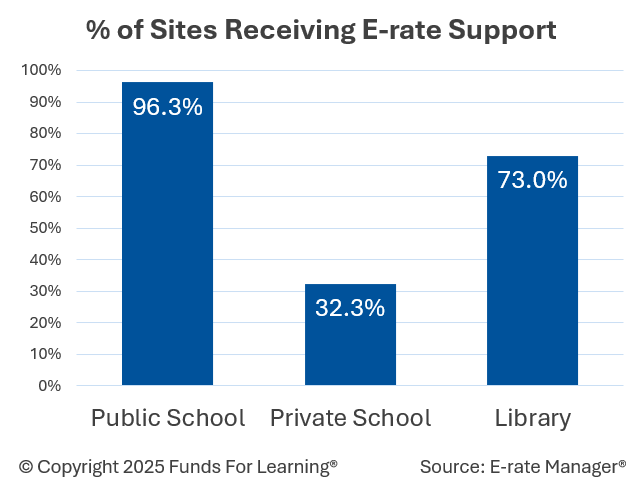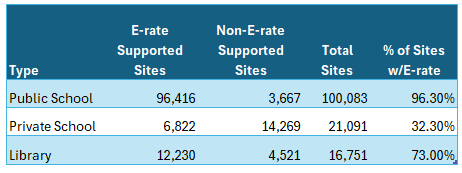New data highlights just how critical the E-rate program has become for America’s classrooms and libraries. From coast to coast, millions of students and community members rely on this support for internet access and Wi-Fi each day.
Public Schools: Nearly Universal Coverage
Of the nation’s 100,083 public schools, 96,416 participate in the E-rate program, an adoption rate of 96.3%. That means fewer than 4% of public schools operate without E-rate support. For most districts, this funding is now woven into the fabric of their technology budgets, as essential as textbooks or classroom supplies in today’s digital learning environment.

Private Schools: Untapped Potential
Private school participation tells a different story. Just 32.3% (6,822 of 21,091) use E-rate discounts. This gap leaves tens of thousands of campuses, and the students they serve, without the benefit of discounted internet and networking services. Whether the barriers are awareness, administrative capacity, or philosophical concerns about federal funding, the opportunity for impact is significant.
Libraries: Anchors for Community Access
Libraries also play a vital role. According to the Institute of Museum and Library Services (IMLS), there are 16,751 public library locations nationwide. Of these, 12,230 receive E-rate discounts, about 73.0% of all library sites. The majority of those that do participate rely on this support to keep their Wi-Fi networks open to the public. For many communities, especially rural and underserved areas, the local library remains the only reliable source of free internet access.
What This Means
Taken together, these figures show E-rate’s outsized role in bridging the digital divide. Public schools have embraced it nearly universally, libraries are using it to anchor community connectivity, and private schools represent the program’s largest growth opportunity.
As we look to future enhancements to the program, one thing is clear: without E-rate, millions of students and library patrons would lose access to the digital tools they need to learn, work, and thrive.
Data Sources:
- Public and private school counts from the National Center for Education Statistics (NCES).
- Library counts from the Institute of Museum and Library Services (IMLS) Public Libraries Survey (2022).
- E-rate participation from Funds For Learning’s E-rate Manager® system.



